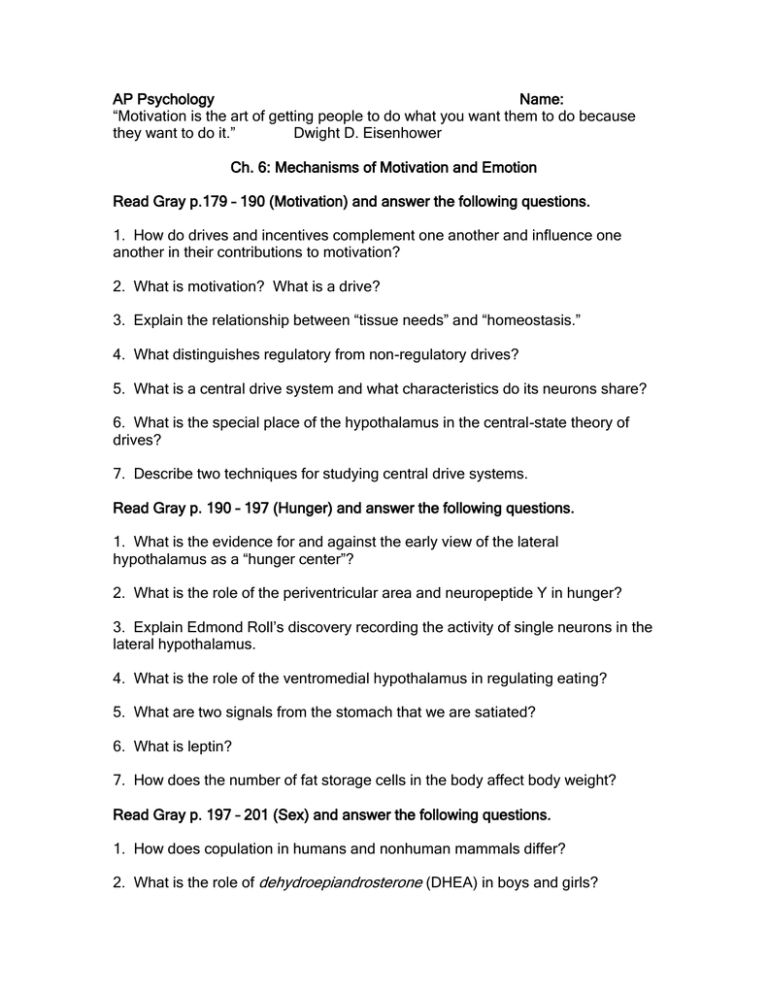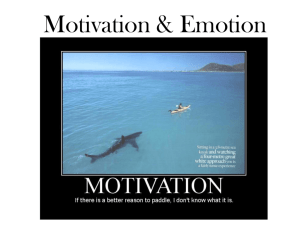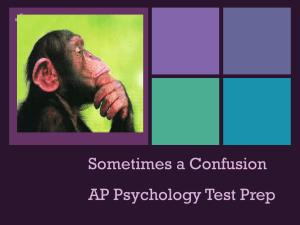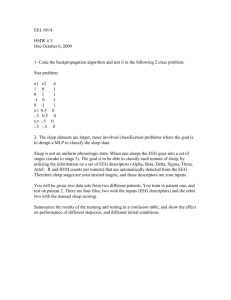File
advertisement

AP Psychology Name: “Motivation is the art of getting people to do what you want them to do because they want to do it.” Dwight D. Eisenhower Ch. 6: Mechanisms of Motivation and Emotion Read Gray p.179 – 190 (Motivation) and answer the following questions. 1. How do drives and incentives complement one another and influence one another in their contributions to motivation? 2. What is motivation? What is a drive? 3. Explain the relationship between “tissue needs” and “homeostasis.” 4. What distinguishes regulatory from non-regulatory drives? 5. What is a central drive system and what characteristics do its neurons share? 6. What is the special place of the hypothalamus in the central-state theory of drives? 7. Describe two techniques for studying central drive systems. Read Gray p. 190 – 197 (Hunger) and answer the following questions. 1. What is the evidence for and against the early view of the lateral hypothalamus as a “hunger center”? 2. What is the role of the periventricular area and neuropeptide Y in hunger? 3. Explain Edmond Roll’s discovery recording the activity of single neurons in the lateral hypothalamus. 4. What is the role of the ventromedial hypothalamus in regulating eating? 5. What are two signals from the stomach that we are satiated? 6. What is leptin? 7. How does the number of fat storage cells in the body affect body weight? Read Gray p. 197 – 201 (Sex) and answer the following questions. 1. How does copulation in humans and nonhuman mammals differ? 2. What is the role of dehydroepiandrosterone (DHEA) in boys and girls? 3. Describe the role of the preoptic area of the hypothalamus in men and the ventromedial area in women. 4. Why is Gray so interested in the sex lives of female musk shrews? 5. Explain testosterone’s role in the development of anatomical structures in humans. Read Gray p. 201 – 212 (Sleep) and answer the following questions. 1. What is an EEG? 2. Describe the stages of sleep and the corresponding EEG wave types. 3. What physiological changes accompany REM sleep? 4. Explain the a) restoration and b) preservation and protection theories of the functions of slow-wave sleep. 5. What is the difference between true dreams and sleep thoughts? 6. Explain two theories of the purpose of REM sleep in humans. 7. What are the roles of the suprachiasmatic nucleus and the pineal gland in regulating sleep? Read p. 212 – 222 (Emotion) and answer the following questions. 1. Describe the Yerkes-Dodson law. 2. Explain James’s peripheral feedback theory of emotion (usually referred to as the James-Lange theory). 3. How is Schacter’s theory similar to James. How does it address some of the criticisms of James’ theory? 4. According to Ekman, what the the basic emotions and how are they linked to facial expressions? How is this theory similar to James’? 5. What evidence is there that different sides of the frontal lobes (i.e. left and right) are mostly involved in either positive or negative emotions?




